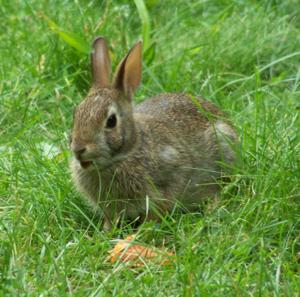The European rabbit is the ancestor from which all domestic breeds of rabbit originally came from.
Physical Characteristics
The European rabbit is 13 ½ to 20 inches long with a 1 ½ to 3 ¼ inch long tail and weighs 2 ¼ to 5 ½ pounds. Its fur is a mix of black and brown with a patch of buff between the shoulders and pale buff around the eyes, on the inner surfaces of the limbs and on the belly.
Behavioral Characteristics
The European rabbit lives in groups called colonies and is very sociable. It is nocturnal, foraging during the night and sleeping during the day. It digs large complex tunnel systems known as warrens. The tunnels have many entrances and exits in case of emergencies. The senior females of a colony are allowed to nest in the main warren but the junior or lower ranking females must dig their own separate short burrows to nest their young in.
Life Cycle
Although the European rabbit breeds all throughout the year more breeding occurs during the first six months then the latter six months. A female has the ability to breed as often as once a month, though most end up with only 6 litters a year. The gestation or pregnancy lasts 28 to 33 days. The litter contains up to 8 offspring with an average of 5. The young are born with closed eyes and placed in a nest of dry grass, moss and the mothers fur for warmth. They are left in the nest all day alone, with the mother only visiting to suckle them a few minutes out of the day. They are weaned between 22 and 31 days and become independent at about 4 weeks. The male and the female reaches sexually maturity at around 8 months old. In the wild this species of rabbit can live up to 9 years but mortality can be as high as 90% during the first year of life.
Diet
The European rabbit is herbivorous. Its diet consists of mostly grass, herbs, twigs and bark.
Habitat
The European rabbit is found in Europe, northwestern Africa, Australia, New Zealand and southern South America. It was originally only located in southwest Europe and northwest Africa until it was introduced into many other regions.
Conservation Status
The European rabbit is classified as near threatened on the IUCN (International Union of Conservation of Nature and Natural Resources) red list of threatened species. Only this rabbit’s natural range is considered for assessment on the IUCN list. Outside its natural range this species is considered a pest and the eradication of the species is considered necessary for the conservation of other animals. Its normal range is Spain, Portugal and Morocco and Algeria in Africa. Within this natural range the population has declined by 95% since 1950 as a result of disease, habitat loss and death caused by humans. It almost qualifies for a vulnerable classification. Decline does not appear to have worsened in recent years but it does continue and the threats that have caused the decline are still present.
References:
Animal: The Definitive Visual Guide to the World’s Wildlife by, David Burnie and Don E. Wilson
Tislerics, A. 2000. “Oryctolagus cuniculus” (On-line), Animal Diversity Web. Accessed August 31, 2009 at http://animaldiversity.ummz.umich.edu/site/accounts/information/Oryctolagus_cuniculus.html.
http://www.iucnredlist.org/details/41291/0

